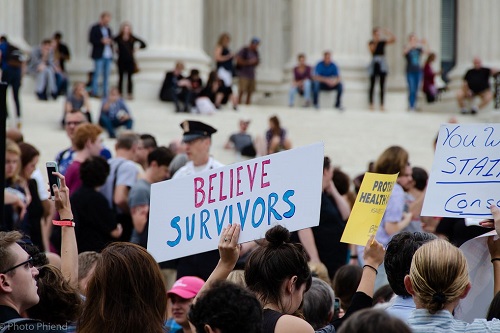By
Jori Hamilton
Sexual harassment has been an issue on college campuses for decades, though more recently, high profile sexual assault cases and the #MeToo movement have helped bring the issue into the spotlight. Although it’s received more attention from the media, the epidemic affects a lot more people than you might think — and little has been done to curb the problem.
According to RAINN, 11.2 percent of all students experience rape or sexual assault through physical force, violence, or incapacitation. For 18- to 24-year old women on campuses, that number increases to 23.1 percent. Furthermore, the number of students who report is astonishingly low. For those who did report, 84 percent experienced the assault during their freshman or sophomore year.
Today, many who are concerned about the alarming frequency of sexual assaults on college campuses are demanding solutions to the problem at hand. After all, ignoring the issue has negatively impacted hundreds of thousands of students, many of which are women. The consequences are abundant, and can range from suicidal ideation, depression, and many students choose to drop out of school altogether. This has made it necessary for college administrators to develop and implement policies that help address the issue head on.
Today, sexual misconduct allegations are handled much differently than they have been in years past.
A decade ago, campuses handled sexual assaults very differently. While schools have always had to address campus sexual assault based on language in both Title IX and the 1990 Clery Act, schools were hardly ever sanctioned, and very few students understood how to lodge Title IX complaints to their schools.
Reporting to law enforcement seemed to do little help. Out of every 1,000 sexual assaults that occur on college campuses, only 310 are reported to law enforcement. Eleven of those reports wind up in court, and of those only seven lead to felony convictions.
Essentially, schools generally followed the path of least resistance, to the detriment of students who had experienced sexual assault. This has since changed— in some ways for the better, and some for the worse.
Under the Obama administration, efforts to curb the epidemic of college sexual assault increased tremendously. This was due, in part, to pressure from the Department of Education, which put schools on notice that if they didn’t put in more effort to protect their students, they could lose federal funding. As a result of complaints to the Department Educations, over 300 investigations into Title IX violations were launched.
Under new leadership, however, it’s unclear if these policies will continue to be enforced as strongly, as the current Secretary of Education Betsy DeVos has declared these policies as a “weaponized version of civil rights,” and has typically expressed interest in giving more rights to parents, local authorities, and state governments, rather than make enforcement a federal issue.
In fact, DeVos recently released the Department of Education’s final draft of new Title IX rules which mandate how schools and universities handle sexual violence allegations. The proposed change of rules would effectively reduce campus liability, provide more support for sexual misconduct victims, while simultaneously bolstering the rights of students who are accused of sexual assault, harassment or rape.
This may have a significant impact on victims.
“A significant revision involves the guarantee that the accused could cross-examine their accusers,” writes Robin Hattersley-Gray for Campus Safety Magazine. “Although the new Title IX rules still allow for this cross-examination, the questioning would now need to be conducted by advisers or attorneys, not the accused. Doing so would prevent a victim from being directly confronted by his or her alleged assailant, thus furthering their victimization. Additionally, the parties could be in different rooms during the interrogation, and the proposal bars questions about a victim’s sexual history. Another change would allow both sides to appeal a ruling.”
On a federal level, it remains unclear how addressing the epidemic will be addressed. Still, many schools are working to combat the issue of college sexual assault on their own. Though there is no universal practice, many schools have responded by creating new Title IX offices on their campuses, and creating new policies that informed how they would investigate and handle instances of sexual assault and misconduct on their individual campuses.
Some of these endeavors are successful — while others may pose direct harm to victims.
Some universities use internal hearings, while others employ a “single investigator” model where one individual is responsible for the investigation of the alleged crime and making a determination of innocence or guilt.
Most colleges, however, have processes that look something like this: After students disclose a sexual assault to a college employee, that employee goes to a Title IX officer who determines whether or not a full investigation is warranted. From there an outside investigator is contacted to gather evidence and interview the parties at hand. This process typically happens within a 60 day period, and afterward parties can appeal.
Other campuses have also taken to tackling the problem first hand, creating pamphlets and programs to help students better understand consent and rape, as well as what to do when reporting.
Still, there have been endeavors that have faced public scrutiny. Some schools, for example, advocate that any and all campus sexual assaults must be reported to the police, arguing that schools would not be allowed to take disciplinary action until there was a conviction. While it may seem like a reasonable solution to some, the situation is far more complicated. Statistics of how often sexual assaults are reported and criminalized, many students — a number of them female — would not receive justice and would likely continue to have to see their abuser on campus each day.
It’s also worth noting that police are already over encumbered by untested rape kits in the United States. Detroit, Michigan alone had a reported 11,304 untested rape kits inside a police storage facility during an audit in 2008.
It’s these kinds of circumstances that make victims unwilling to come forward. As the community organization End the Backlog notes, “The backlog of untested rape kits represents the failure of the criminal justice system to take sexual assault seriously.”
While it’s unclear whether these kinds of policies will help in the long term, or what the future holds as it applies to sexual assault on US college campuses, it will nonetheless be an issue that is in the public eye for years to come.
Jori Hamilton
Jori Hamilton is a writer from the United States who is passionate about social justice, education, and politics. You can follow her work on twitter @HamiltonJori



No Comments Yet!
You can be first to comment this post!